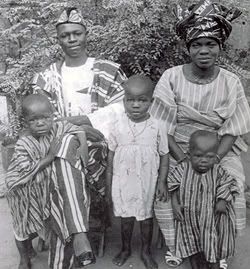 It's important that students are familiar with Nigerian geography, history, politics, and culture before reading Soyinka's memoir in earnest.
It's important that students are familiar with Nigerian geography, history, politics, and culture before reading Soyinka's memoir in earnest. If they should need such an introduction, students could begin by studying a 1913 Map of Africa as drawn up by British colonizers, situating Nigeria in the larger African continent. Similarly, they could find Abeokuta as situated in Nigeria by examining this Administrative Map of Nigeria. If the classroom has a computer with an adequate internet connection, the class could also use Google Earth (which must be downloaded first) to look at Abeokuta and Nigeria as it is today.
Once students can place the story geographically, they should then examine its historical, political, and cultural aspects. This site, a compilation of research by the Library of Congress, offers a wealth of information, organized categorically – main headings include history, society, environment, economy, and government – which can facilitate lesson organization and student exploration of the context surrounding this book. We would recommend reading the historical overview, about influence of the Christian missions, colonial Nigeria, and politics in the crisis years to begin with.
Soyinka himself often talks about Nigerian history and politics in interviews and speeches which might prove valuable to watch during this introductory exploration. One such example is this clip in which Soyinka discusses democracy and power in Nigeria.
Learning about the egúngún (or other such cultural practices) prior to or during the first few chapters of Soyinka's memoir could help bring the atmosphere of Aké to life for students.
The Brighton & Hove City Council Royal Pavilion, Museums & Libraries has created a wonderful resource concerning egúngún masquerade rituals. The information included discusses the history of the masquerade, the make and purpose of costumes and masks, as well as the roles of the participants. Please visit their site by clicking here and exploring via the sidebar on the left.
There are also many videos of the egúngún masquerade and parade which can be viewed online depicting authentic attire, dance, and procession.
It can be very beneficial for students to hear the an author's own voice reading their text, especially when that author's voice is particularly expressive. In a BBC World Book Club interview with Harriett Gilbert, Wole Soyinka both discusses his memoir and reads excerpts from it with vibrancy and humor. Please click here and scroll to the very bottom of the page to find Soyinka's interview. The clip is somewhat long (nearly half an hour), but it's easy to cue up certain sections to play in class. For easy reference, his excerpts begin at 2 minutes 30 seconds (2:30) and 18 minutes 50 seconds (18:50). This clip could also be revisited and listened to in its entirety once students have finished reading the book since Soyinka addresses audience and caller questions about his memoir.
Additionally, The Nobel Foundation recently interviewed Soyinka, the first six minutes of which touches upon his childhood, his family, and his experiences in Aké. To watch the video, please visit their site and click the word "Play" at the bottom of the page. Included on this page is a handy summary of the discussion with approximate times of each topic shift for easy cueing.
Harry Kreisler also interviewed Soyinka in 1998 at UC, Berkeley. Although they do not talk about his memoir in particular, they do discuss his background, writings, politics, and theories as expressed through his work. The interview can be watched here, or the entire transcript can be read here.
Postcolonial Web has also put together a fantastic, comprehensive resource specifically intended for reading Aké in an educational setting, breaking up the memoir into thematic chunks such as history, politics, setting, characterization, image & symbol, genre, and religion among others. They also offer a list of fourteen deep questions relating closely to the text which could be be given to students to help guide their reading and analysis, as an ongoing journal response assignment, or as a summative assessment after finishing the memoir.
Finally, after reading Aké, we recommend that students familiarize themselves with the proceeding events of Soyinka's life as well as with others of his works. We've included a brief updated biography on this blog, but The Nobel Foundation has compiled a more comprehensive biography of the 1986 Nobel Literature Laureate, as well as a comprehensive list of his writings, and a recording and transcript of his Nobel Prize acceptance speech. As mentioned above, the Nobel site also includes a fantastic interview with Soyinka that includes discussion of his childhood years and beyond (please click "Play" at the link to watch the video).
